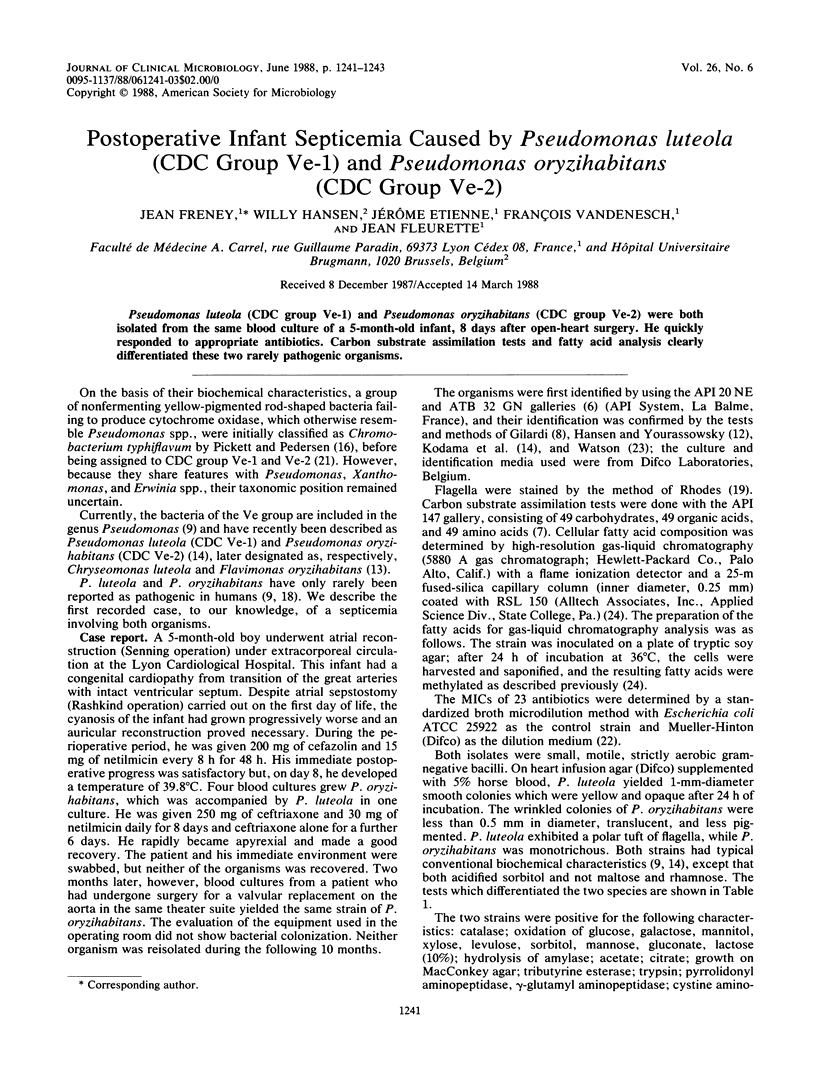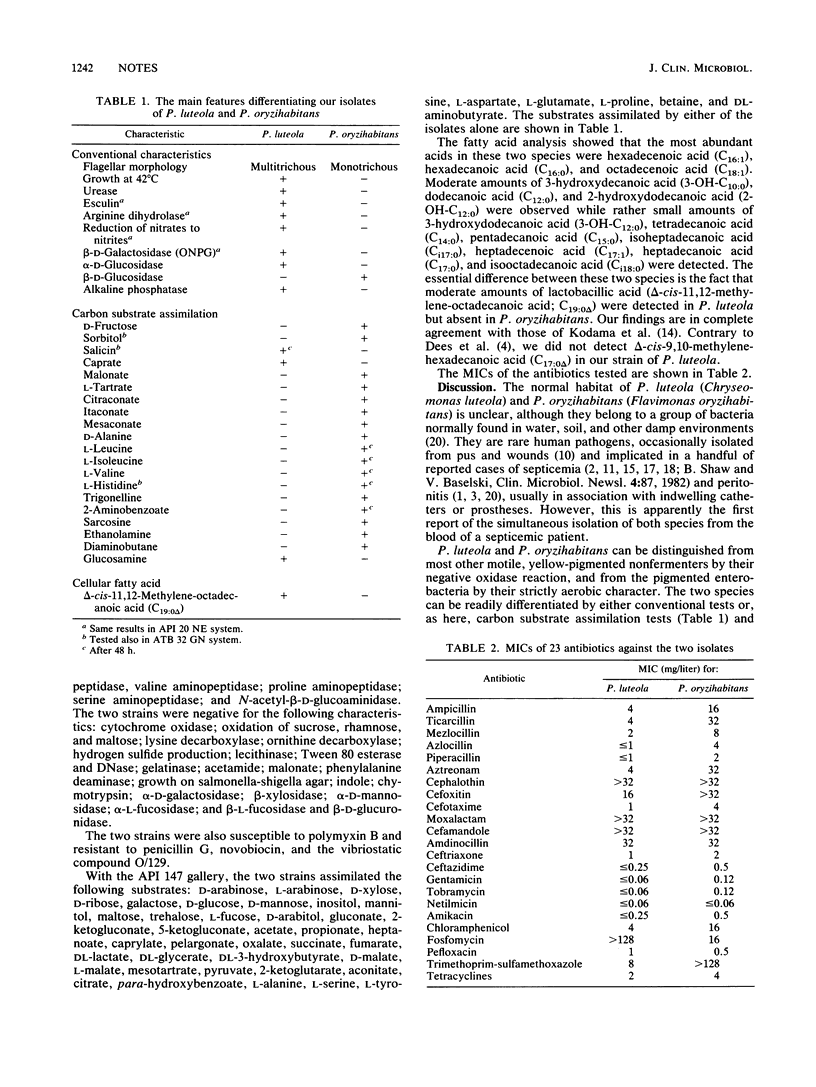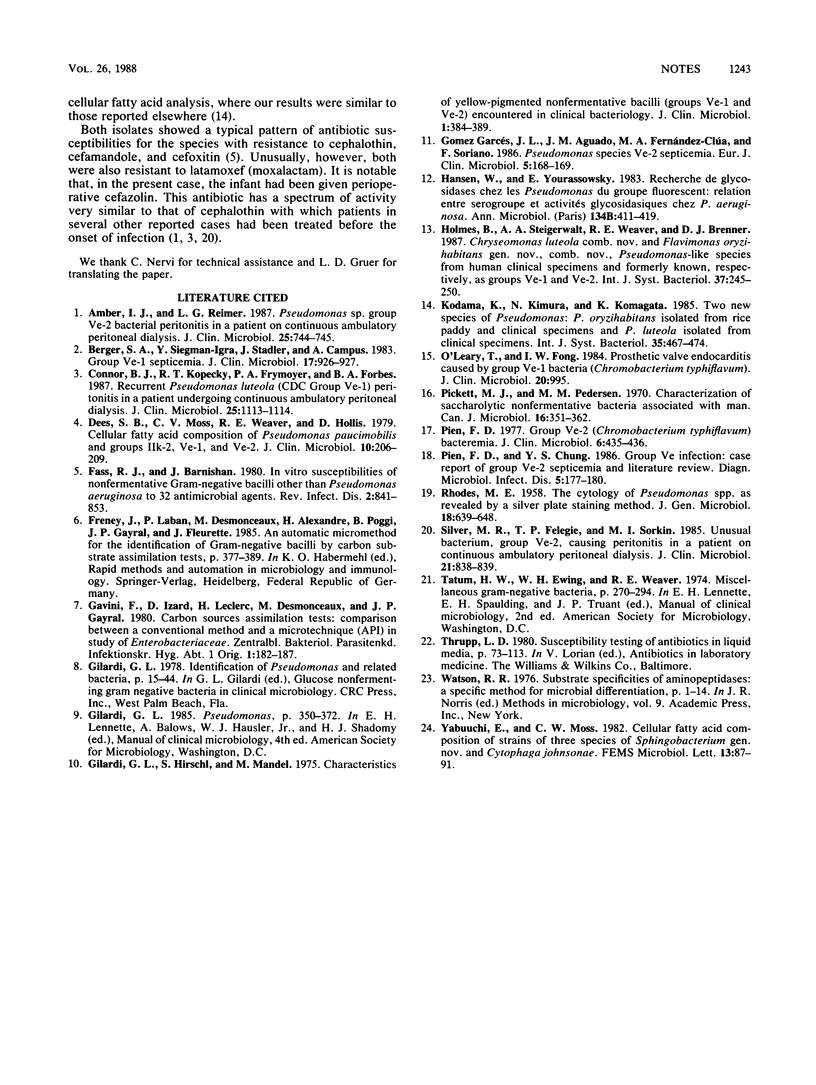Abstract
Pseudomonas luteola (CDC group Ve-1) and Pseudomonas oryzihabitans (CDC group Ve-2) were both isolated from the same blood culture of a 5-month-old infant, 8 days after open-heart surgery. He quickly responded to appropriate antibiotics. Carbon substrate assimilation tests and fatty acid analysis clearly differentiated these two rarely pathogenic organisms.
Full text
PDF


Selected References
These references are in PubMed. This may not be the complete list of references from this article.
- Amber I. J., Reimer L. G. Pseudomonas sp. group Ve-2 bacterial peritonitis in a patient on continuous ambulatory peritoneal dialysis. J Clin Microbiol. 1987 Apr;25(4):744–745. doi: 10.1128/jcm.25.4.744-745.1987. [DOI] [PMC free article] [PubMed] [Google Scholar]
- Berger S. A., Siegman-Igra Y., Stadler J., Campus A. Group VE-1 septicemia. J Clin Microbiol. 1983 May;17(5):926–927. doi: 10.1128/jcm.17.5.926-927.1983. [DOI] [PMC free article] [PubMed] [Google Scholar]
- Connor B. J., Kopecky R. T., Frymoyer P. A., Forbes B. A. Recurrent Pseudomonas luteola (CDC group Ve-1) peritonitis in a patient undergoing continuous ambulatory peritoneal dialysis. J Clin Microbiol. 1987 Jun;25(6):1113–1114. doi: 10.1128/jcm.25.6.1113-1114.1987. [DOI] [PMC free article] [PubMed] [Google Scholar]
- Dees S. B., Moss C. W., Weaver R. E., Hollis D. Cellular fatty acid composition of Pseudomonas paucimobilis and groups IIk-2, Ve-1, and Ve-2. J Clin Microbiol. 1979 Aug;10(2):206–209. doi: 10.1128/jcm.10.2.206-209.1979. [DOI] [PMC free article] [PubMed] [Google Scholar]
- Fass R. J., Barnishan J. In vitro susceptibilities of nonfermentative gram-negative bacilli other than Pseudomonas aeruginosa to 32 antimicrobial agents. Rev Infect Dis. 1980 Nov-Dec;2(6):841–853. doi: 10.1093/clinids/2.6.841. [DOI] [PubMed] [Google Scholar]
- Gilardi G. L., Hirschl S., Mandel M. Characteristics of yellow-pigmented nonfermentative bacilli (groups VE-1 and VE-2) encountered in clinical bacteriology. J Clin Microbiol. 1975 Apr;1(4):384–389. doi: 10.1128/jcm.1.4.384-389.1975. [DOI] [PMC free article] [PubMed] [Google Scholar]
- Gómez Garcés J. L., Aguado J. M., Fernández-Clúa M. A., Soriano F. Pseudomonas species Ve-2 septicemia. Eur J Clin Microbiol. 1986 Apr;5(2):168–169. doi: 10.1007/BF02013978. [DOI] [PubMed] [Google Scholar]
- Hansen W., Yourassowsky E. Recherche de glycosidases chez les Pseudomonas du groupe fluorescent: relation entre sérogroupe et activités glycosidasiques chez P. aeruginosa. Ann Microbiol (Paris) 1983 Nov-Dec;134B(3):411–419. [PubMed] [Google Scholar]
- O'Leary T., Fong I. W. Prosthetic valve endocarditis caused by group Ve-1 bacteria (Chromobacterium typhiflavum). J Clin Microbiol. 1984 Nov;20(5):995–995. doi: 10.1128/jcm.20.5.995-.1984. [DOI] [PMC free article] [PubMed] [Google Scholar]
- Pickett M. J., Pedersen M. M. Characterization of saccharolytic nonfermentative bacteria associated with man. Can J Microbiol. 1970 May;16(5):351–362. doi: 10.1139/m70-062. [DOI] [PubMed] [Google Scholar]
- Pien F. D., Chung E. Y. Group Ve infection: case report of group Ve-2 septicemia and literature review. Diagn Microbiol Infect Dis. 1986 Jul;5(2):177–180. doi: 10.1016/0732-8893(86)90120-3. [DOI] [PubMed] [Google Scholar]
- Pien F. D. Group VE-2 (Chromobacterium typhiflavum) bacteremia. J Clin Microbiol. 1977 Oct;6(4):435–436. doi: 10.1128/jcm.6.4.435-436.1977. [DOI] [PMC free article] [PubMed] [Google Scholar]
- RHODES M. E. The cytology of Pseudomonas spp. as revealed by a silver-plating staining method. J Gen Microbiol. 1958 Jun;18(3):639–648. doi: 10.1099/00221287-18-3-639. [DOI] [PubMed] [Google Scholar]
- Silver M. R., Felegie T. P., Sorkin M. I. Unusual bacterium, group Ve-2, causing peritonitis in a patient on continuous ambulatory peritoneal dialysis. J Clin Microbiol. 1985 May;21(5):838–839. doi: 10.1128/jcm.21.5.838-839.1985. [DOI] [PMC free article] [PubMed] [Google Scholar]


